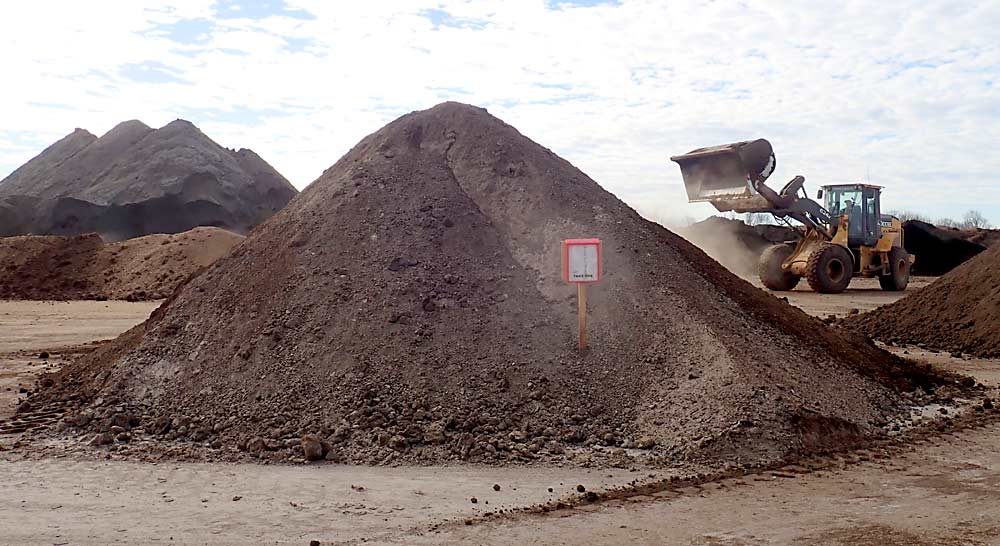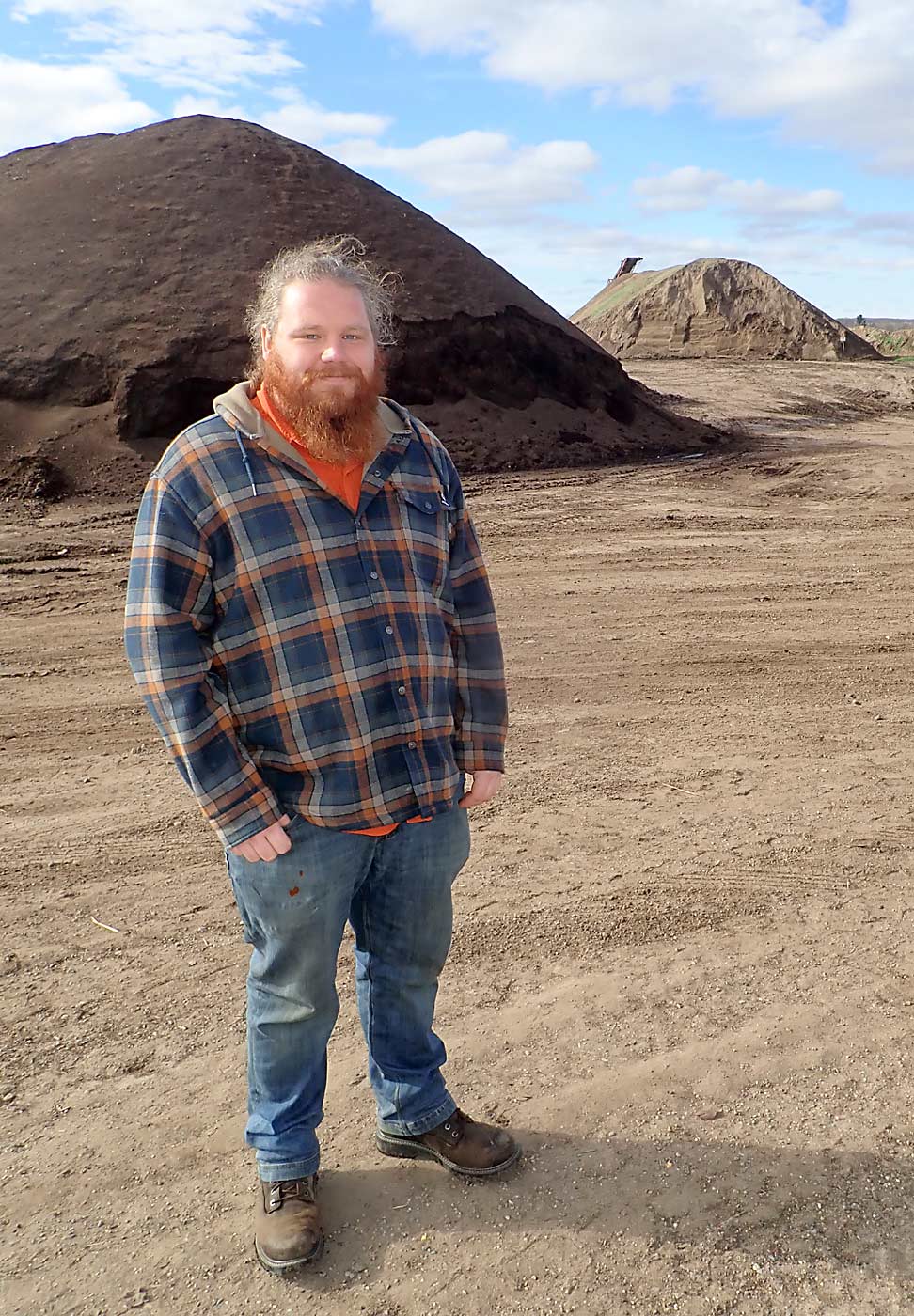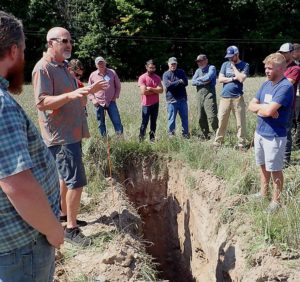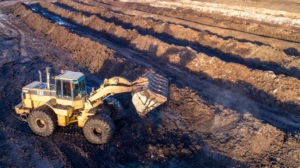
Compost makes for richer soil, but it comes with a lot of questions: What are the uses for manure-based versus plant-based composts? How much should I apply, and when? Is it worthwhile to make my own?
The answers to those questions may vary from one farm to another, but a good general knowledge of the topic will help growers get more from their soil, according to composting experts Theo Medendorp and Dave Bos. Medendorp is an agronomist at Morgan Composting Inc., a major Michigan producer of organic compost — including its well-known Dairy Doo brand. Bos is a vineyard consultant and co-owner of Bos Wine, located in northwestern Lower Michigan.
Manure vs. vegetation?
Morgan Composting’s operation produces tens of thousands of cubic yards of compost every year, almost all of which is made with manure from dairy cattle. Manure compost is generally higher in nutrition than vegetative compost, which translates to lower application rates, Medendorp said.
“With Dairy Doo, we usually don’t recommend more than 0.25–0.5 inches, and even a half inch is a pretty heavy nutrient load, whereas the leaf compost can be applied at a lot heavier rates, even up to 2–3 inches, and that just comes from the lower nutritional content,” he said.
The company’s composts come in numerous mixes, which might include things like wood ash for added potassium content or tree bark for a high-carbon product that makes a good alternative to leaf compost, Medendorp said. Leaf compost is often made with leaves collected by municipalities, so it might not be as clean and consistent.
Determining which composts are a good fit for a vineyard or orchard depends on what the grower expects from the soil and what composts can provide. That means growers need to know the current state of their soil. Soil tests and soil pits are the best way to do that, Bos said. Soil pits can be especially beneficial to understand soils before putting in a new vineyard, he said.
“That’s something I’ve been harping on, because you can just learn so much,” Bos said. “With so many more vineyards that are going to be going in, this is the perfect time to dial it in, and (soil pits) will provide the most helpful information for you to understand and envision what’s going on under the ground.”
Once growers know their soil conditions and their needs, they can narrow down their composting options. Before purchasing compost, however, growers should know what they are getting, Medendorp said. At Morgan Composting’s operation, manure goes through a three- to four-month composting process, which includes turning the compost while also monitoring temperature to ensure it reaches at least 131 degrees Fahrenheit for 15 days, and then curing it.
The proper temperature and turning are essential to clear the compost of detrimental microorganisms and make it safe for application, he said, so growers should ask the composter for turning/temperature records and/or microbial testing results. Turning/temperature records are also important for plant-based composts, because they can help lower the chances that the compost will bring a new weed or disease to the farm, he said.
DIY compost?
Although it is possible to make manure-based compost, fruit growers today often have few if any animals on the farm, so buying manure-based compost is the best option, said Bos.
“I think I’ve been to all of the little dairies around here, and none of them have manure for sale. They all use it themselves, because they’re smart,” he said.
Vegetative compost is more doable, but even that requires some forethought and attention, Medendorp said. In general, vegetative compost requires both the carbon-providing “browns,” such as leaves, straw and sawdust, and the nitrogen-providing “greens,” such as grass clippings or manures.
“The most common mistake comes down to the carbon-to-nitrogen ratio, so you have to keep track of what you’re adding,” Medendorp said. “There are many useful calculators online that will get you in the ballpark.”

Besides keeping an eye on the carbon-nitrogen ratio, growers should monitor the moisture of the compost pile, keeping it in the 40 to 60 percent moisture and 131 to 155 degree range for good microbial activity, he said, noting that higher temperatures can kill the microorganisms and stop decomposition in its tracks. Following these guidelines is particularly critical for treating compost in an orchard or vineyard that already has a foliar disease issue or accepts off-site vegetation that may introduce new diseases or weeds.
Another tip for DIY composters is to occasionally check for unpleasant odors emanating from the pile. This may mean insufficient aeration, which can be resolved by turning, or too high a green-to-brown ratio, which can be remedied by adding more browns.
Why, when and how?
Bos is a longtime proponent of composting. Back in 2005, he helped convert the large Grgich Hills vineyards in California to organic and biodynamic farming, and he has continued his push for composting since moving back to his home state of Michigan six years ago.
“The trend that I saw when I was in California — and that we will see here — is that the biodynamic, extreme organic folks start using compost, then it moves into the organic world, and then it moves to everybody else, because they start to see the long-term benefits of composting every year,” Bos said.
In Northwest Michigan, for instance, he said compost can help retain nutrients in the highly drainable, sandy loam soil under most vineyards.
“Compost is rich with humic colloids, which are like little super-saturated particles that allow for the holding of nutrients, so a vine’s root tip can come find them,” he said. “And the compost is also feeding the cover crops and feeding the other life in the soil, (so) if you have been composting for a number of years in your vineyard, you will have this diversity of life that helps roots grow and your cover crops thrive, and makes nutrients more available.”
Bos especially favors manure-based compost: “When you start looking at the microbial life and what’s in your soil, it’s really hard to get the type of diversity and balance you want to see in compost if you don’t bring in manure.”
In new vineyards, he suggests starting out by adding 5 yards of compost per acre, and then adding more over time, based on the results of soil tests and a soil pit analysis.
“That is how you’re going to have a more complete picture of whether you want to add things to your compost, or if you want to try to be more specific to your site,” he said.
Although tilling has been tied to carbon sequestration, Bos believes it is warranted for incorporating compost deeper into the soil of a new vineyard.
For established vineyards preparing to plant cover crop seeds, he recommends lightly discing compost into the soil. For Michigan growers who already have a good cover crop system in place, they might opt to add a light layer of compost in the spring and let the rain wash it into the soil.
Over the last few years, Bos said he sees the benefits from composting and other green practices in Northwest Michigan showing up in better fruit quality.
“We have a lot of people coming up here and starting to notice that things taste better, fresher, healthier. Food quality is never going to be a thing that we’ve solved — it’s going to be a continual push forward,” he said. “Composting is the backbone of good farming.”
—by Leslie Mertz








Leave A Comment